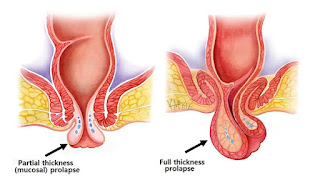LAPAROSCOPIC RECTOPEXY
Laparoscopic rectopexy
Laparoscopic rectopexy is a surgery to repair a rectal prolapse, a protrusion of the rectum through the anus. In this surgery, the rectum is restored to its normal position in the pelvis.
Rectal prolapse
What is rectal prolapse?
Patients with a rectal prolapse have a protrusion (prolapse) of the rectum through the anus. The rectum folds on itself and protrudes through the anal canal.
symptoms of the rectal prolapse
1.change in bowel habits
2.rectal bleeding
3.mucus drainage
4.anorectal pain
5. fecal incontinence
A rectal prolapse is thought to occur because of a loss or weakness of the normal support structures for the rectum.
What is laparoscopic rectopexy?
Laparoscopic rectopexy is one of the surgeries that is used to repair a rectal prolapse. In this surgery, the rectum is restored to its normal position in the pelvis, so that it no longer protrudes through the anus. Usually, stitches are used to secure the rectum, often along with mesh.
The term "laparoscopic" refers to surgery performed through several very small incisions in the abdomen. A laparoscope (a long, thin camera) is placed through an incision near the belly button in order to see the inside of the abdomen. The other small incisions are used to place instruments to perform the surgery.
How Should I Prepare for Laparoscopic rectopexy?
You will need a full physical examination. You might need some tests to make sure you are healthy enough for surgery.
The surgeon who will do your laparoscopic surgery will talk with you about the risks and benefits of surgery. Then you will sign a form saying you understand and agree to the operation. Your surgeon’s office will tell you what to do and avoid before surgery. The exact instructions depend on your surgeon, but here are some common things to do.
Take a shower the night before surgery or the same morning. Your surgeon might ask you to use an antibiotic soap. Please do not shave your belly area.
Stop eating and drinking at the time your doctor tells you before surgery.
The morning of your surgery, you may take medications your doctor told you are allowed. Take them with just a sip of water.
You might need to stop taking certain medicines before surgery. These include blood thinners, supplements, and medicines that affect your immune system. Talk to your surgeon when you schedule your laparoscopic rectopexy.
You will need someone to drive you home from surgery. You will also need someone to stay with you overnight. Ask your doctor or nurse how much help you might need.
What happens during the laparoscopic rectopexy surgery?
There are main steps to this surgery:
-Positioning the laparoscope:
Once you are under anesthesia, the surgeon will make a small cut (about 1/2 inch) near the belly button. A laparoscope will be inserted into the abdomen through this incision. Images taken by the laparoscope will be projected onto monitors.
Once the laparoscope is in place, the surgeon usually makes several more small incisions in the abdomen .The number and position of these incisions depends on the size and shape of your abdomen, the preference of the surgeon and other factors. Long, thin surgical instruments will then be placed through these incisions to complete the surgery.
-Freeing up the rectum and pulling it up so it no longer protrudes
surgeon will begin the surgery by locating the sigmoid colon and rectum. Next, the rectum will be freed from its surrounding structures and gently lifted into its proper position inside the pelvis.
-Securing the rectum
Stitches will be placed around the rectum to secure it in place. Mesh may be used along with the stitches. In some cases, your surgeon may remove a portion of your sigmoid colon. He or she will discuss with you before the surgery whether this is a possibility.
Finally, the pelvis will be rinsed out and the incisions will be stitched closed. Your stitches will be dissolvable and under the skin; you will not have any stitches that need to be removed.
When surgery is finished, the surgeon closes your incisions with tiny stitches, staples, surgical tape or glue. These disappear as you heal, so the doctor does not need to remove them later.






Comments
Post a Comment